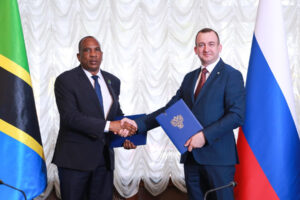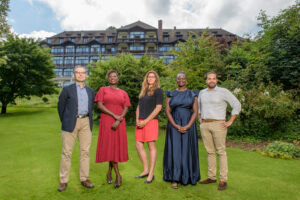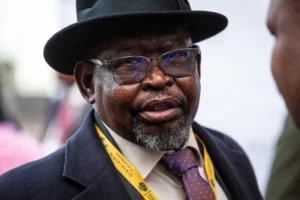- Russia and Tanzania unite to double trade, boost Africa market access
- History as Janngo Capital seals Africa’s largest gender-equal $78M tech VC fund
- South Africa Budget Disappoints Investors as Deficit Widens
- Kenya drops to 6th place in Africa trade barometer
- Tanzania’s bold move to boost cashew nut exports by 2027
- Chinese cities dominate global list of places occupied by billionaires
- Sudan tops up as Africa aims for $25 billion development fund
- Opportunities for youth: Tech firms Gebeya and NVIDIA to train 50,000 developers in Africa
Author: Laurence Sithole
I am a financial services professional with a strong background in diverse areas of banking. My skill set includes among others International Banking, Trade Finance, Commercial Lending, Customer Service, Finance, Banking, Corporate Finance, and Investment Banking. Africa is my home and I am passionate about its development,
The government of Zimbabwe through its ministry of mines and mineral development expressed its intent to create and develop a US$12 billion mining industry by 2023. This is not a far-fetched goal. It is feasible especially since this number is approximately the same amount that one large global mining company, Rio Tinto, earned as profits in the six months to June this year. The mining industry in Zimbabwe is estimated to be worth in the region US$4 billion.
The southern African country can achieve this in two years provided it meets certain conditions precedent for the growth of the mining sector. Natural resources are available in vast commercial quantities, and they are diverse. The US Department of Commerce through its International Trade Administration (ITA) division described the sector as “the best prospect industry” for the nation.
There is great potential in the mining sector that can be harnessed for
In a previous article, it was established from research that private investors globally have at least US$500 billion in funds under management which they desire to deploy in the development of infrastructure projects across Africa. Africa being the continent that needs this most is ironically the continent that spends the least on the development of its infrastructure. The potential and scope for funding African infrastructure is enormous; however such potential is hamstrung by the state and management of public finances and the debt levels of African governments.
Statistics show that less than 10% of infrastructure projects in Africa reach completion and that 80% fail at the feasibility and business planning stage. Projects fail for various reasons the biggest being limited capabilities, which include the ability to draw up realistic budgets, designs, and implementation of the said infrastructure projects with commercial potential due to short political cycles that challenge commitments to
A lot has been written about the case for investing in Africa.
Many journalists and economists have eulogized about the merits of investing in Africa going as far as to describe it as the final frontier. Africa is indeed the so-called final frontier and it is that for very good reason. It has the largest share of any natural resources on the planet that are still untapped for the most part. It is not an exaggeration to describe the continent as a Utopian Eldorado as far as investment is concerned. It is home to the youngest population demographic who will comprise a large part of the middle class and will consume large quantities of services and goods.
A typical example and an apt preface for this article would be the massive coal deposits in the Waterberg area in the north of South Africa. This resource is estimated to be in
Special Drawing Rights (SDRs) are a reserve asset created by the International Monetary Fund (IMF) to supplement its member countries’ reserves.
According to the IMF’s website, a total equal to US$943 billion in SDRs has been allocated to date from the time they were created in 1969. This figure is inclusive of the SDR456 billion approved on the 2nd of August 2021. This most recent allocation was made necessary by the need to help countries around the world to cope with the effects of the COVID-19 pandemic. The value of the SDR is based on a basket of five currencies which include: the US dollar, the euro, the Chinese renminbi, the Japanese yen, and the British pound. …
The Reserve Bank of Zimbabwe (RBZ) prefaced its policy review by stating that inflationary pressures have dissipated which it called conducive and supportive of its expected economic growth rate of 7.8 per cent in 2021.
The policy review was characterized by optimism on the part of the monetary authorities as it painted a rosy economic outlook. The tone of the document was very upbeat with the RBZ expecting global economic recovery from the adverse effects of the coronavirus pandemic because of the stimulus packages whose effects it is expected will trickle down to emerging economies and special drawing rights (SDR) allocations adding up to US$650 billion. …
Not to be mistaken the adverse impact of the times have been felt at Richemont with sales for the half-year ending 30 September 2020 decreasing significantly by 26 per cent to €5.48 billion against the previous year. This decline in sales resulted in a fall in operating profits of 61 per cent from €1.165 billion to €452 million.
Notwithstanding this slowdown in profits, the company was able to deliver a 78 per cent increase in sales from their China market which has now been overtaken by the Americas as the company’s largest market.…
Numerous advantages and benefits have been proffered to explain the motives individuals have for moving their assets offshore and investing in jurisdictions other than their home countries. Standard Bank reckons that offshore investment aids in capitalizing on circumstances outside the country providing a buffer against our markets, our inflation spikes and exchange rate fluctuations.
Essentially, offshore investment serves as a hedge against the volatility and harsh economic fundamentals in the local economy. Zimbabwe as a case in point has suffered from perennial poor economic performance for the greater part of the last two decades. The economic phase that characterized this period included compulsory expropriation of productive farmland, the expropriation of hard currency funds that were never returned, of individuals and organizations by the government to fund its operations, hyperinflation and a generally depressed economy.…
[elementor-template id="94265"]
The banks themselves have little confidence in each other which is demonstrated by the absence of a real interbank lending market.
Perhaps most striking is the high degree of regulatory risk. Regulatory risk is one where a change in laws and regulations will materially impact a security, business, sector, or market. A change in laws or regulations made by the government or a regulatory body can increase the costs of operating a business, reduce the attractiveness of an investment, or change the competitive landscape in each business sector. In extreme cases, such changes can destroy a company's business model.…
[elementor-template id="94265"]
Since then the company has pursued a highly aggressive growth strategy constituting of both organic and acquisitive growth. Sibanye in a very short space of time acquired the Cooke operations from Gold One International in 2013 and the Burnstone project from Wits Gold the following year. The aim of this aggressive growth strategy was to produce more sustainable gold operations.
The story of growth did not stop there.
Soon the company set its sights on the platinum sector and began to snap up various interests and operations in that space. In 2016 Sibanye acquired the Aquarius Platinum’s Rustenburg operations namely Kroondal mine as well as the Platinum Mile treatment facility in South Africa and in Zimbabwe it took over the Mimosa joint venture with Impala Platinum. Later that year the company also bought the Rustenburg operations of Anglo Platinum.…
[elementor-template id="94265"]
Anglo American is a leading global mining company, with a world-class portfolio of mining and processing operations and undeveloped resources, with more than 95,000 people working for it around the world, in 15 countries. This company on the 29th of July announced its intention to disburse an additional US$2 billion to its shareholders through what it described as an on-market irrevocable and non-discretionary share buyback programme of $1 billion together with a special dividend of $0.80 per ordinary share, equal to $1 billion. All in all, the company intends to return at least US$4 billion in cash to its shareholders when what the company describes as its base dividend of US$4.1 billion is considered.
Anglo American will repurchase up to 204.3 million shares in terms of the buy-back programme that started August 12 and ending no later than 14 February 2022. The US$2.1 billion ordinary dividends is being paid out…




